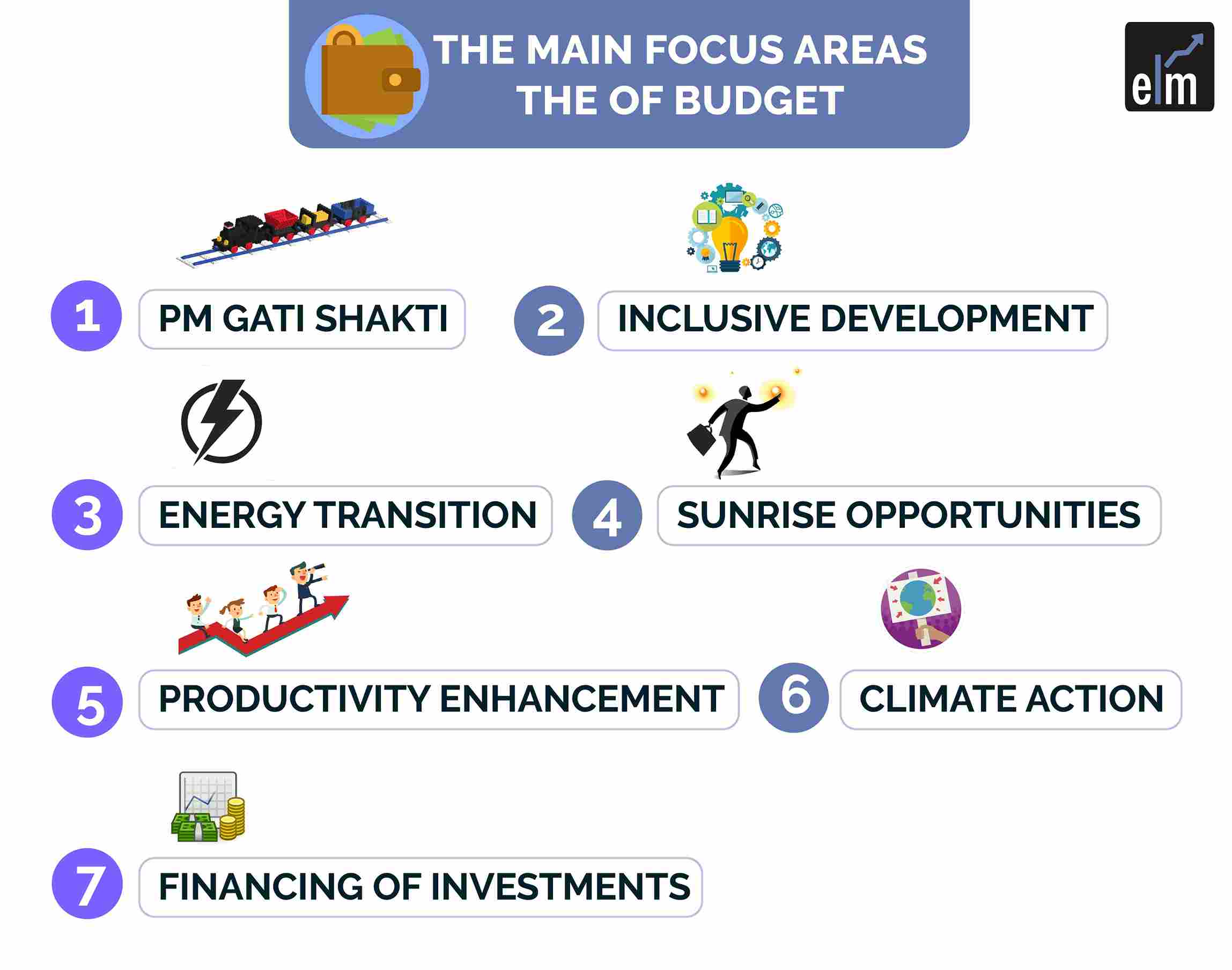Budget 2022!! Yes, the Financial Minister of our country, Nirmala Sitharaman, announced the Budget for 2022-2023 today.
The Indian Stock Market indices remained solid as Finance Minister Nirmala Sitharaman delivered the Union Budget to Parliament.
The best-performing sector was banking, followed by metals and healthcare.
This year’s Budget is mainly growth-oriented and CAPEX related Budget. As the capital expenditure is being stepped up to Rs 7.5 lakh crore. FY23 CAPEX seen at 2.9% of GDP, and FY23 effective CAPEX seen at Rs 10.7 lakh crore
Also, the Finance Minister announced that the gross GST collections for January 2022 are Rs 1,40,986 crores which is the highest since the inception of GST.
The main focus areas discussed in the Budget today were PM Gati Shakti, Inclusive Development, Productivity Enhancement, Opportunities, Energy Transition, Climate Action and Financing of investment.

Let us discuss the highlights covered in the Budget 2022 today-
- Top 19 Highlights Covered in Budget 2022
- 1. PM Gati Shakti
- 2. Emergency Credit Line Guarantee Scheme (ECLGS )
- 3. For Indian Farmers
- 4. Digital Ecosystem
- 5. Small Enterprises
- 6. Financial Inclusion
- 7. Educational Sector
- 8. E-Passports
- 9. Urban Planning
- 10. Electric Vehicles
- 11. PM Awas Yojna
- 12. Defence Sector
- 13. Sovereign Green Bond
- 14. Digital Rupee
- 15. Tax for cooperative societies
- 16. Cryptocurrency
- 17. Announcement for TaxPayers
- 18. Infrastructure
- 19. Duty Exemptions
Top 19 Highlights Covered in Budget 2022
1. PM Gati Shakti
PM Gati Shakti’s Masterplan will advance the economy by creating more jobs and opportunities for the youth. It will include the seven engines of economic change.
PM Gatishakti highway concept will be developed in the coming fiscal year. In 2022-23, the National Highway network will be enlarged by 25,000 kilometres.
In FY23, four contracts for multi-modal national parks will be granted.
The Gati Shakti programme will provide railways with a boost. In the next three years, 400 new Vande Bharat trains will be designed and built. The concept of “one station, one product” will be popularised to aid small enterprises. In the next three years, India hopes to build 100 cargo terminals
2. Emergency Credit Line Guarantee Scheme (ECLGS )
It will be extended until March 2023, with a guaranteed cover increase of Rs 50,000 crore. The scheme now has a total cover of Rs 5 lakh crore. An additional sum has been set aside for the hospitality industry.
3. For Indian Farmers
In India, chemical-free natural farming will be promoted. Kisan drones will be pushed for crop evaluation, land record digitization, and insect pesticide spraying—also, MSP direct payments to wheat and paddy farmers totalling Rs 2.37 lakh crore.
4. Digital Ecosystem
Digital ecosystem for upskilling and livelihood will take place this financial year.
This programme will use online training to educate, reskill, and upskill citizens. To locate appropriate jobs and possibilities, API-based skill credentials and payment layers are used.
An open platform for the digital health ecosystem will be launched.
5. Small Enterprises
MSMEs like Udyam, e-shram, NCS & Aseem portals will be inter-linked and also their scope will be widened.
They will now act as portals with live organic databases, delivering G-C, B-C, and B-B services, including credit facilitation and expanding entrepreneurial chances.
A fund with blended capital raised under NABARD’s will support agriculture and rural enterprises for the farm product value chain.
6. Financial Inclusion
All 1.5 lakh post offices will come under the core banking system, allowing for financial inclusion and account access via net banking, mobile banking, and ATMs, as well as online fund transfers between the post office and bank accounts.
This would be especially beneficial to farmers and senior residents in rural areas, allowing for interoperability and financial inclusion.
7. Educational Sector
States will be urged to alter agricultural university curricula to fit the needs of natural, low-cost, organic farming and modern-day agriculture.
PM eVIDYA’s “one class, one TV channel” programme will be expanded from 12 to 200 channels.
As a result, all states will provide extra education in regional languages to students in grades 1 through 12.
8. E-Passports
E-passports, the issuance of E passports using embedded chips and futuristic technology will be rolled out in 2022-23 to enhance the convenience for the citizens in their overseas travel.
9. Urban Planning
For recommendations on urban capacity building, planning execution, and governance, a high-level group of urban planners and economists will be constituted.
10. Electric Vehicles
To strengthen the EV ecosystem, a battery-swapping regulation will be introduced along with interoperability standards.
11. PM Awas Yojna
PM Awas Yojana has been allocated Rs 48, 000 crores.
In 2022-23, 80 lakh dwellings will be completed for PM Awas Yojana beneficiaries; 60,000 houses will be identified as PM Awas Yojana beneficiaries in rural and urban locations.
60,000 crores have been set aside to provide tap water to 3.8 crore households.
80 lakh families will be identified for the affordable housing scheme in 2022-2023.
12. Defence Sector
Through the SPV model, private industry will be encouraged to collaborate with DRDO and other organizations to design and manufacture military platforms and equipment.
In 2022-23, 68% of the defence capital procurement budget will go to local industry (up from the 58% last fiscal).
Defence R&D will be opened up for industry, start-ups and academia with 25% of the defined R&D budget.
13. Sovereign Green Bond
The funds will be utilized for projects that will assist to reduce the economy’s carbon intensity.
In FY23, the government will issue sovereign green bonds as part of its borrowing programme. Proceeds will be used to fund public-sector projects.
14. Digital Rupee
RBI plans to develop a digital rupee based on blockchain technology in 2023.
In addition, the digital currency will result in a more efficient and cost-effective currency management system. As a result, it is suggested that the Reserve Bank of India produce digital rupees utilizing blockchain and other technology beginning in 2022 and 2023.
15. Tax for cooperative societies
The Alternative Minimum Tax for cooperative societies will be reduced to 15%.
For cooperative societies with an annual income of between Rs 1 crore and Rs 10 crore, the proposal will cut the surcharge to 7%.
16. Cryptocurrency
Also, the gift of cryptocurrencies will be taxed at the receiver’s end.
You can also join our course on THE FUNDAMENTALS OF CRYPTOCURRENCY & BLOCKCHAIN
17. Announcement for TaxPayers
Taxpayers have two years from the end of the relevant assessment year to make an updated return on payment of taxes.
According to FM, the new rule will encourage voluntary tax submission and reduce litigation.
The proceeds of virtual/digital assets are subject to a 30% tax, with no deductions other than the purchase cost.
There is no allowance for set-off against other income. Payments made for the transfer of digital assets will be subject to a 1% TDS.
Employer contributions to the National Pension System (NPS) are now deducted at 14% for state government employees, up from 10% previously.
18. Infrastructure
Auctions for the 5G spectrum will be held in 2022. The production-linked strategy will include a design-led manufacturing scheme for 5G.
To award contracts for installing optical fibre in rural areas, with a completion date of 2025. In 2022/23, 480 billion rupees will be made aside for affordable housing.
An additional 195 billion rupees would be allocated for production-linked incentives for solar equipment manufacturers.
19. Duty Exemptions
Over 350 exemptions will be phased out on agricultural products, chemicals, pharmaceuticals, and other items.
Capital goods will be subject to a phase-out of concessional customs duties, with an initial rate of 7.5 per cent to be levied.
You can also visit web.stockedge.com is a unique platform, which is 100% focused on research and analytics.
Bottomline
The above were the main points that are covered in the Budget today. Overall the Budget is good for the capital market and overall economy.
We hope you found this blog informative and use it to its maximum potential in the practical world. Also, show some love by sharing this blog with your family and friends and helping us in our mission of spreading financial literacy.
Happy Investing!










